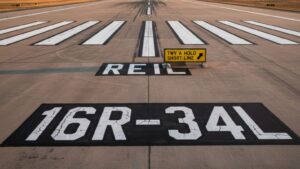Thunderstorms are unpredictable and incredibly powerful. Most passengers bring a few minutes of anxiety, a rough patch of turbulence and hope that it’ll all pass soon. But for a pilot in the cockpit, flying through a storm is a test of training, teamwork, technology and instincts. It’s not about bravado. It’s about discipline, experience and calm decision-making under pressure.
This is not a tale of near-misses or dramatic rescues. It’s about what it really feels like to fly a commercial aircraft into, around and, if needed, through a storm. It’s about the quiet confidence that pilots carry into such moments and what they rely on when the weather turns hostile.
The Build-Up: Reading the Weather Before Take-off
No flight enters a storm by surprise. Before any commercial aircraft takes off, pilots and their operations team study weather data extensively. Radar images, satellite feeds, SIGMETs (Significant Meteorological Information), METARs (weather reports) and NOTAMs (Notices to Airmen) all play a part in the planning. Flight dispatchers work alongside pilots to evaluate the safest and most efficient route. If there’s a storm system along the way, alternate flight paths and emergency diversion airports are mapped out in advance.
Pilots also pay close attention to wind patterns, storm movement speed and the likelihood of lightning or hail. The goal isn’t to challenge nature but to work around it. Sometimes, waiting on the tarmac for 30 extra minutes can mean avoiding hours of turbulence mid-air.
Inside the Cockpit: Calm Amid Chaos
The cockpit doesn’t look like a Bollywood storm scene when turbulence hits. There’s no dramatic music, no shouting over radio signals. What you’ll find instead is controlled communication.
Once in flight, if a storm system becomes unavoidable, the crew activates weather radar and scans for convective cells, zones within the storm that show the most dangerous turbulence. They coordinate with air traffic control (ATC), adjust altitude or heading and communicate with other nearby aircraft to gather real-time updates.
The pilot flying (PF) stays focused on keeping the aircraft stable, while the pilot monitoring (PM) assists with navigation, communications and systems management. This division of duties helps maintain situational awareness.
Flying through a storm is not always about evasion. Sometimes, it’s about managing the experience, reducing speed, turning on anti-ice systems, dimming the cabin lights and briefing the cabin crew and passengers. The priority is always safety and comfort.
What It Feels Like: The Human Side of the Yoke
Pilots are trained to handle tough weather, but that doesn’t mean they’re indifferent to it. The first time you enter a storm as a trainee, your hands instinctively grip the controls tighter. You feel the vibration of the aircraft, hear the rattle of raindrops hitting the windshield and see flashes of lightning nearby. Your senses sharpen, and you’re more aware of every sound and movement.
But with time, training kicks in. You start relying on numbers more than your nerves. Airspeed, altitude and rate of climb or descent all become your language of control. You don’t overreact; you adjust. You trust the aircraft. You trust your co-pilot. And most importantly, you trust your own judgement.
Turbulence might toss the aircraft around like a paper boat in the wind, but the plane is built for it. Wings flex, the fuselage holds strong and systems continue working. Passengers may feel every bump, but pilots see it as data, just another challenge to handle with precision.
Communication: The Heartbeat of Safety
During rough weather, communication becomes even more critical. Pilots maintain constant contact with air traffic control, relay position reports and inform controllers of any significant changes in flight conditions. If rerouting is required, they work with ATC to find clear airspace. In especially stormy sectors, aircraft often line up like dancers in a coordinated routine, each being carefully spaced and guided to avoid overlaps.
Communication with the cabin crew is just as important. The cockpit keeps the crew informed so they can manage the cabin, secure trolleys, help nervous passengers and ensure everyone is buckled up.
At times, pilots also make PA announcements. A calm, clear voice from the flight deck often reassures passengers more than anything else. “We’re experiencing some turbulence ahead. Nothing to worry about. Please remain seated with your seatbelts fastened”. Those words carry weight because they come from someone who has flown through dozens of storms before and knows what they’re doing.
Technology: The Unseen Co-Pilot
Modern aircraft are technological marvels. Weather radars onboard can scan miles ahead, distinguishing between light rain and severe thunderstorms. Some systems even offer predictive wind shear warnings. Enhanced flight management systems calculate new routes in seconds, while autopilot helps maintain control even in complex conditions.
But technology isn’t a replacement for the pilot. It’s a tool. Pilots must interpret what the systems show, filter what’s useful and decide what action to take. Even autopilot has limits; it can disengage if turbulence crosses a certain threshold, putting the aircraft back in human hands.
That’s why training matters. Every hour in the simulator, every mock scenario of engine failure in bad weather and every bit of muscle memory comes into play when the real clouds get dark.
Lessons from the Sky
Flying through storms teaches pilots more than how to handle turbulence. It teaches patience. It teaches respect for nature, for machines and for teamwork.
One of the most valuable lessons is humility. No matter how many hours you’ve logged, the sky always has new lessons. A pilot never approaches a storm lightly. Overconfidence has no place in the cockpit. Caution, preparedness and professionalism are what keep everyone safe.
The View After the Storm
Ask any experienced pilot, and they’ll tell you that flying through a storm is not about thrill or courage. It’s about clarity under pressure. It’s about using every bit of training, every ounce of experience and every available resource to get everyone safely to their destination.
Pilots don’t chase storms. They prepare for them. And when the skies get rough, they don’t panic; they fly.







